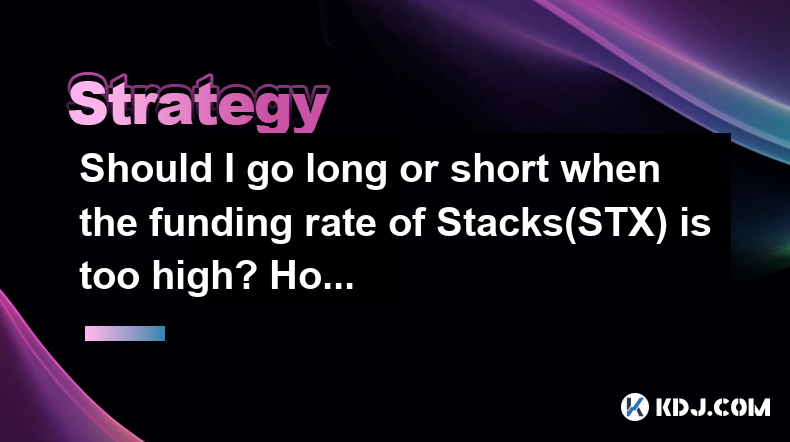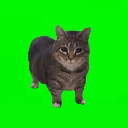-
 bitcoin
bitcoin $112715.707551 USD
-1.71% -
 ethereum
ethereum $4101.475385 USD
-3.01% -
 tether
tether $1.000644 USD
-0.02% -
 bnb
bnb $1207.619465 USD
-6.77% -
 xrp
xrp $2.501451 USD
-3.98% -
 solana
solana $202.947124 USD
-3.32% -
 usd-coin
usd-coin $1.000295 USD
0.04% -
 dogecoin
dogecoin $0.203884 USD
-4.47% -
 tron
tron $0.317154 USD
-1.72% -
 cardano
cardano $0.695009 USD
-4.43% -
 hyperliquid
hyperliquid $38.853961 USD
-8.23% -
 chainlink
chainlink $18.988674 USD
-4.64% -
 ethena-usde
ethena-usde $1.000233 USD
-0.03% -
 stellar
stellar $0.337050 USD
-3.63% -
 bitcoin-cash
bitcoin-cash $536.861728 USD
-1.28%
Should I go long or short when the funding rate of Stacks(STX) is too high? How to arbitrage?
When STX funding rates are high, traders can go long if bullish, short if bearish, or exploit arbitrage opportunities, but must consider market, liquidity, and execution risks.
May 04, 2025 at 08:35 am

When considering whether to go long or short on Stacks (STX) when the funding rate is high, it's crucial to understand what the funding rate signifies and how it can influence your trading strategy. The funding rate in cryptocurrency futures markets is a mechanism that ensures the price of perpetual futures contracts remains close to the spot price of the underlying asset. When the funding rate is high, it typically means that the market is bullish, with long positions paying a premium to short positions to keep their positions open.
The decision to go long or short on STX when the funding rate is high depends on your market outlook and risk tolerance. If you believe the bullish trend will continue, going long could be profitable despite the high funding rates. However, if you anticipate a market correction or a bearish turn, going short could be advantageous as you would receive the funding payments from long positions.
To go long on STX when the funding rate is high:- Open a futures trading account on a platform that supports STX perpetual futures.
- Deposit the necessary margin into your account.
- Navigate to the STX perpetual futures trading section.
- Place a long order at your desired entry price.
- Monitor the position and the funding rate, as high funding rates can erode profits if the price does not move favorably.
- Similarly, open a futures trading account on a platform that supports STX perpetual futures.
- Deposit the required margin.
- Go to the STX perpetual futures trading section.
- Place a short order at your desired entry price.
- Keep an eye on the position and the funding rate, as high funding rates can add to your profits if the price moves in your favor.
Understanding Arbitrage Opportunities with High Funding Rates
Arbitrage is the practice of taking advantage of price differences in different markets to generate a profit with minimal risk. When the funding rate of STX is high, there are potential arbitrage opportunities that traders can exploit.
One common arbitrage strategy involves the spot-futures arbitrage. Here, traders buy STX on the spot market and simultaneously sell STX futures contracts. The high funding rate can provide additional income to the arbitrageur, as they will receive the funding payments from the short position.
To execute a spot-futures arbitrage on STX:- Identify a platform that offers both STX spot trading and STX perpetual futures.
- Check the current spot price of STX and the price of the STX perpetual futures.
- If the futures price is higher than the spot price by more than the cost of carry (including the funding rate), an arbitrage opportunity exists.
- Buy STX on the spot market.
- Simultaneously, sell an equivalent amount of STX perpetual futures.
- Hold the position until the futures contract expires or until the price difference narrows.
- Close both positions to realize the profit, which includes the price difference and any funding payments received.
Risks and Considerations in Arbitrage
While arbitrage can seem like a risk-free way to profit, there are several risks and considerations that traders must be aware of.
Market risk is a significant factor, as the price of STX can move unfavorably, causing losses on either the spot or futures position. Liquidity risk is another concern, as insufficient liquidity on either the spot or futures market can make it difficult to enter or exit positions at desired prices.
Execution risk is also critical, as delays in executing trades can lead to missed opportunities or losses. Traders must ensure they have fast and reliable access to trading platforms.
To mitigate these risks:- Use limit orders to control entry and exit prices.
- Monitor market conditions closely and be ready to adjust positions.
- Ensure you have sufficient margin to cover potential losses.
- Consider using automated trading systems to reduce execution risk.
Funding Rate Arbitrage Strategies
Funding rate arbitrage is another strategy that traders can use when the funding rate of STX is high. This involves taking advantage of the funding rate itself to generate income.
To execute a funding rate arbitrage:- Identify a platform that offers STX perpetual futures with a high funding rate.
- Open a short position on STX perpetual futures.
- Hold the position through the funding period to receive the funding payments.
- Close the position to realize the profit from the funding payments.
Practical Steps for Funding Rate Arbitrage
To implement a funding rate arbitrage strategy effectively:- Choose a reputable exchange that offers STX perpetual futures.
- Monitor the funding rate closely, as it can change frequently.
- Calculate the potential income from the funding rate and compare it to the potential risk of holding the short position.
- Use stop-loss orders to limit potential losses if the market moves against your position.
- Consider using leverage to increase potential returns, but be aware of the increased risk.
Frequently Asked Questions
Q: How often does the funding rate for STX change, and how can I track it?A: The funding rate for STX typically changes every eight hours, although this can vary depending on the exchange. You can track the funding rate through the trading platform's interface or by using third-party tools and APIs that provide real-time data on funding rates.
Q: Can I use automated trading bots for arbitrage on STX?A: Yes, automated trading bots can be used for arbitrage on STX. These bots can monitor price differences and execute trades automatically, potentially increasing efficiency and reducing the risk of human error. However, it's important to choose a reliable bot and to monitor its performance closely.
Q: What is the impact of transaction fees on arbitrage profits for STX?A: Transaction fees can significantly impact arbitrage profits. When calculating potential profits, it's essential to account for fees on both the spot and futures markets. High transaction fees can erode profits, especially in strategies with narrow profit margins. Always compare fees across different platforms to maximize your arbitrage returns.
Q: Is it possible to arbitrage STX across different exchanges?A: Yes, it is possible to arbitrage STX across different exchanges, but it involves additional complexity and risk. You would need to monitor price differences and funding rates across multiple platforms and execute trades simultaneously. Additionally, consider the risks of cross-exchange arbitrage, such as delays in fund transfers and differences in exchange policies.
Disclaimer:info@kdj.com
The information provided is not trading advice. kdj.com does not assume any responsibility for any investments made based on the information provided in this article. Cryptocurrencies are highly volatile and it is highly recommended that you invest with caution after thorough research!
If you believe that the content used on this website infringes your copyright, please contact us immediately (info@kdj.com) and we will delete it promptly.
- XRP Price Prediction: Weekend Rollercoaster or Rally?
- 2025-10-12 08:45:16
- Bittensor (TAO): Super Bullish Signals Point to Potential 2x Rally
- 2025-10-11 10:25:12
- Silver Price Correction: Navigating the Dip & Identifying Key SEO Keywords
- 2025-10-11 10:25:12
- Decoding Crypto Trends: Bittensor's Bull Run, Cardano's Dip, and LivLive's Presale Buzz in 'Uptober 2025'
- 2025-10-12 08:45:16
- MoonBull: The Crypto Meme Coin Promising 1000x Gains?
- 2025-10-11 10:30:01
- Crypto Payroll Revolution: Stablecoins, Altcoins, and the Future of Salary Payments
- 2025-10-11 10:30:01
Related knowledge

Practical parameter settings for a Bitcoin multi-timeframe moving average system
Sep 18,2025 at 10:54pm
Optimizing Timeframe Combinations for Bitcoin Trading1. Selecting appropriate timeframes is crucial when building a multi-timeframe moving average sys...

How can I filter out false breakouts in Dogecoin high-frequency trading?
Sep 22,2025 at 01:00am
Understanding False Breakouts in Dogecoin Trading1. A false breakout occurs when Dogecoin's price appears to move beyond a defined support or resistan...

Techniques for identifying tops and bottoms in the Bitcoin on-chain NVT model
Sep 20,2025 at 07:54pm
Understanding the NVT Model in Bitcoin Analysis1. The Network Value to Transactions (NVT) ratio is often described as the 'P/E ratio' of the cryptocur...

What does the surge in open interest in Bitcoincoin futures mean?
Sep 20,2025 at 11:18pm
Understanding the Surge in Dogecoin Futures Open Interest1. A surge in open interest within Dogecoin futures indicates a growing number of active cont...

How can I use the Ethereum USDT premium to gauge market sentiment?
Sep 18,2025 at 11:55pm
Understanding the Ethereum USDT Premium1. The Ethereum USDT premium refers to the price difference between USDT (Tether) traded on Ethereum-based plat...

What should I do if Ethereum staking yields decline?
Sep 20,2025 at 06:18am
Understanding the Causes Behind Declining Ethereum Staking Yields1. The Ethereum network transitioned to a proof-of-stake consensus mechanism with the...

Practical parameter settings for a Bitcoin multi-timeframe moving average system
Sep 18,2025 at 10:54pm
Optimizing Timeframe Combinations for Bitcoin Trading1. Selecting appropriate timeframes is crucial when building a multi-timeframe moving average sys...

How can I filter out false breakouts in Dogecoin high-frequency trading?
Sep 22,2025 at 01:00am
Understanding False Breakouts in Dogecoin Trading1. A false breakout occurs when Dogecoin's price appears to move beyond a defined support or resistan...

Techniques for identifying tops and bottoms in the Bitcoin on-chain NVT model
Sep 20,2025 at 07:54pm
Understanding the NVT Model in Bitcoin Analysis1. The Network Value to Transactions (NVT) ratio is often described as the 'P/E ratio' of the cryptocur...

What does the surge in open interest in Bitcoincoin futures mean?
Sep 20,2025 at 11:18pm
Understanding the Surge in Dogecoin Futures Open Interest1. A surge in open interest within Dogecoin futures indicates a growing number of active cont...

How can I use the Ethereum USDT premium to gauge market sentiment?
Sep 18,2025 at 11:55pm
Understanding the Ethereum USDT Premium1. The Ethereum USDT premium refers to the price difference between USDT (Tether) traded on Ethereum-based plat...

What should I do if Ethereum staking yields decline?
Sep 20,2025 at 06:18am
Understanding the Causes Behind Declining Ethereum Staking Yields1. The Ethereum network transitioned to a proof-of-stake consensus mechanism with the...
See all articles


























![Staking ATH: How To Stake $ATH in October 2025 with 523% APY — [Step-By-Step Guide] Staking ATH: How To Stake $ATH in October 2025 with 523% APY — [Step-By-Step Guide]](/uploads/2025/10/15/cryptocurrencies-news/videos/staking-ath-stake-ath-october-apy-stepstep-guide/68eef94d80903_image_500_375.webp)















































